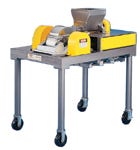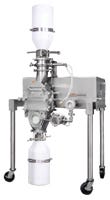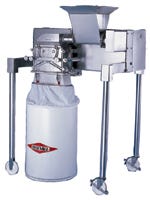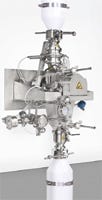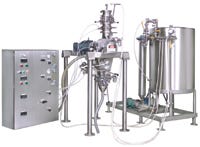July 9, 2007
 The evolution of size reduction equipment, particularly in the pharmaceutical industry, is one of gradual adaptation to meet higher standards of sanitation and safety.
The evolution of size reduction equipment, particularly in the pharmaceutical industry, is one of gradual adaptation to meet higher standards of sanitation and safety.
Size reduction equipment has evolved over the years with respect to Good Manufacturing Practices (GMPs). Original mill designs included pan-fed models for which operators were required to hand feed product to the milling chamber at a desired rate. Because this required the implementation of standard operating parameters and operator training to ensure the proper rate was maintained, supervision and operating costs could be significant and quality not ensured. The photo at left shows a typical pan-fed mill.
In order to eliminate operator-to-operator variations and to validate that the correct feed rate was maintained, automated feed systems were developed. Controls became available to set the desired feed rate as well as monitor and document that these rates were maintained. A photo of a mill with a feed-screw system is shown above.
|
Pan-fed mill |
The need for easier cleaning and the ability to validate that equipment is suitably clean and ready for the next batch required significant redesign of equipment. Requirements include parts that were small enough for typical operators to easily disassemble, clean, and inspect. Additionally, designing components into a sealed technical enclosure became preferred, since cleaning these components was not required. This type of design is shown in the photo on page 37, right.
Containment: the Next (Current) Generation
Airborne dust is always undesirable and often dangerous. Containment of the product in the process equipment requires customized solutions because of the variety of methods used to bring material to and from the equipment. In any case, the interfacing between material transport and the equipment must be done in a contained manner. This interface is typically the area with the highest potential of dust egress.
|
Mill with auger feed system |
A product containment system contains the product inside the process components of the system. This is particularly difficult with a milling system since the rotor in the mill will typically act as a fan and blow air down, creating a positive pressure in the discharge of the system. Whenever a positive pressure exists, product seeks escape to the atmosphere. The design of a containment system utilizes some of the techniques that are used in barrier isolators (glove boxes). The system is mechanically sealed with appropriately designed gaskets and seals. An air-venting system is then used to draw off the process gas and actually operate the whole process at a slight negative pressure. The design of the air-venting system must include filters that keep the product inside the equipment. A filter-cleaning system is also included to keep these filters clean in order to operate over the extended period of time required for the various batches.
|
Bin-to-bin milling system with containment valves |
An example of a contained milling system is seen in the photo on page 37, left, which shows a bin-to-bin milling system. The material is contained at the feed and at the discharge by means of split butterfly valves.
Nitrogen Inerting to Prevent Explosion (and Meet ATEX Requirements)
A second advantage of the vacuum-venting system of the product containment system is that it facilitates nitrogen inerting. Since the process gas is drawn out of the system in a controlled manner, it is possible to sample the gas and monitor for oxygen level. By injecting nitrogen at the top of the process, and controlling the amount of nitrogen to maintain a desired oxygen level in the discharge gas, a safe processing environment can be established, maintained, and monitored. The controls are designed to prevent operation of the equipment if these safe conditions do not exist.
|
Assembled D6A mill |
ATEX is a European directive that regulates explosion prevention when four conditions are fulfilled simultaneously: inflammable product, air, atmospheric conditions (T&P), and an ignition source. Nitrogen purging of the process area—the area designed to contain dust—removes “air” from the above list and therefore the installation automatically meets ATEX requirements.
Clean in Place (CIP)
|
In-wall bin-to-bin CIP mill |
Containing the product during processing is only part of the challenge in the pharmaceutical industry. The processes are typically batch processes in which the equipment must be thoroughly cleaned and validated to be clean prior to being able to be used in the next batch. Historically, equipment has been designed to be easily disassembled for cleaning. The problem is that, in disassembling the equipment, operators are exposed to the residual dust that coats the interior of the product contact surfaces. Washing in place (WIP) is an option where the inside is sprayed with water or solution to preclean the system and wet down the powder to prevent it from becoming airborne. There is still a risk of exposure since the product is still present, diluted in a liquid suspension that is on the equipment.
CIP is a much higher standard in which the equipment is validated to be clean after the CIP process. CIP utilizes a CIP skid that contains a reservoir of water and the means of bringing it up to the required temperature, a self-draining pump to pump the solution to the equipment at the appropriate pressure and flow rate, detergent pumps to inject detergents into the fluid at the appropriate time, and instruments and controls to ensure the proper conditions exist.
|
Free-standing CIP mill with CIP skid |
CIP is not able to be added to just any equipment. Equipment must be designed in such a fashion that the cleaning fluid is able to reach every surface with sufficient force and volume to clean it. A photo of an in-the-wall CIP mill is seen at left, and a photo of a free-standing CIP mill with the CIP skid is shown below.
Size reduction equipment has come a long way in the last 25 years and will undoubtedly change even more in the next 25 years.
Scott Wennerstrum is Marketing and Technical Director at The Fitzpatrick Co., Elmhurst, IL, a global leader in process technology that offers products such as the FitzMill Comminutor, the Chilsonator roll compactor, the FitzSieve cone mill, and the Fitz-cM classifying mill. He has an MBA from Illinois Institute of Technology and a BS in Mechanical Engineering from the University of Tulsa and can be reached at [email protected] or 630-530-3333. For more information on The Fitzpatrick Co., visit www.fitzmill.com.
About the Author(s)
You May Also Like


